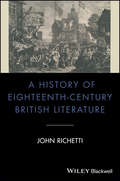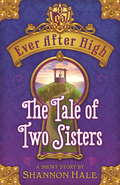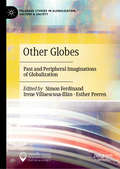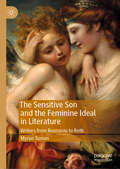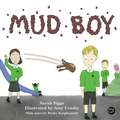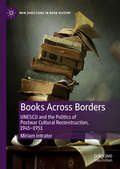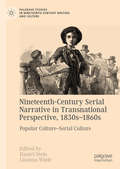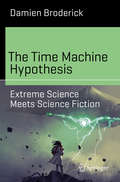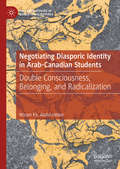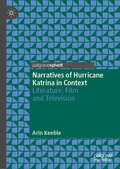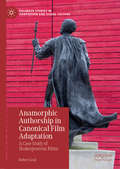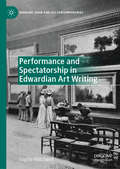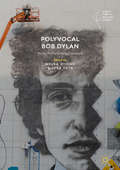- Table View
- List View
A History of Eighteenth-Century British Literature (Blackwell History of Literature)
by John RichettiA History of Eighteenth-Century British Literature is a lively exploration of one of the most diverse and innovative periods in literary history. Capturing the richness and excitement of the era, this book provides extensive coverage of major authors, poets, dramatists, and journalists of the period, such as Dryden, Pope and Swift, while also exploring the works of important writers who have received less attention by modern scholars, such as Matthew Prior and Charles Churchill. Uniquely, the book also discusses noncanonical, working-class writers and demotic works of the era. During the eighteenth-century, Britain experienced vast social, political, economic, and existential changes, greatly influencing the literary world. The major forms of verse, poetry, fiction and non-fiction, experimental works, drama, and political prose from writers such as Montagu, Finch, Johnson, Goldsmith and Cowper, are discussed here in relation to their historical context. A History of Eighteenth-Century British Literature is essential reading for advanced undergraduates and graduate students of English literature. Topics covered include: Verse in the early 18th century, from Pope, Gay, and Swift to Addison, Defoe, Montagu, and Finch Poetry from the mid- to late-century, highlighting the works of Johnson, Gray, Collins, Smart, Goldsmith, and Cowper among others, as well as women and working-class poets Prose Fiction in the early and 18th century, including Behn, Haywood, Defoe, Swift, Richardson, Fielding, and Smollett The novel past mid-century, including experimental works by Johnson, Sterne, Mackenzie, Walpole, Goldsmith, and Burney Non-fiction prose, including political and polemical prose 18th century drama
Victorian Environmental Nightmares
by Laurence W. Mazzeno Ronald D. MorrisonThe twelve essays in Victorian Environmental Nightmares explore various “environmental nightmares” through applied analyses of Victorian texts. Over the course of the nineteenth century, writers of imaginative literature often expressed fears and concerns over environmental degradation (in its wide variety of meanings, including social and moral). In some instances, natural or environmental disasters influenced these responses; in other instances a growing awareness of problems caused by industrial pollution and the growth of cities prompted responses. Seven essays in this volume cover works about Britain and its current and former colonies that examine these nightmare environments at home and abroad. But as the remaining five essays in this collection demonstrate, “environmental nightmares” are not restricted to essays on actual disasters or realistic fiction, since in many cases Victorian writers projected onto imperial landscapes or wholly imagined landscapes in fantastic fiction their anxieties about how humans might change their environments—and how these environments might also change humans.
Private Worlds
by Sarah GainhamPrivate Worlds completes Sarah Gainham's masterly trilogy of twentieth-century Austria. Having survived the Second World War and Vienna's lethal post-war political intrigues, Julia Homburg, Vienna's most brilliant actress, and her trusted friend Georg Kerenyi can now return to their private worlds, restore their shattered lives and reaffirm the values that enabled them to transcend the hate, injustice and crimes of those war-torn years. They are determined to seek out the consolation of work, the sweetness of love, the joy of friendship -- but memories of the destruction and suffering they witnessed are not always easily buried . . .
The Tale of Two Sisters: Tale Of Two (Ever After High #7)
by Shannon HaleIn Shannon Hale's Ever After High: The Storybook of Legends the two heroines Raven Queen and Apple White discover a lost fairytale.For the first time, read the full version of that fairytale as an exclusive short story from the author!(Please note, this story is 1,200 words long.)
Frights, Camera, Action!: The Junior Novel 3 (Monster High)
by Perdita FinnWhen Draculaura is led to believe she's the rightful heir to the vampire throne, she and her best ghoulfriends are whisked away to Transylvania for a royal coronation to die for. But they soon discover the hunt for the queen is not over yet. The Ghouls must locate an ancient artifact known as the Vampire's Heart in order to discover the identity of the true Vampire Queen. It's a fangtastic adventure that will lead them from the Tower of Londoom, to a haunted river boat in New Goreleans and finally to the glamorous boo-vie lots of Hauntlywood. Could this be the moment when Draculaura finally receives her vampire powers and discovers screams really can come true?Based on the Monster High movie: Frights, Camera, Action! Contains eight pages of full-colour images in addition to the story. Don't miss the other books based on Monster High movies: Haunted and Freaky Fusion.
Other Globes: Past and Peripheral Imaginations of Globalization (Palgrave Studies in Globalization, Culture and Society)
by Simon Ferdinand Irene Villaescusa-Illán Esther PeerenThis volume challenges dominant imaginations of globalization by highlighting alternative visions of the globe, world, earth, or planet that abound in cultural, social, and political practice. In the contemporary context of intensive globalization, ruthless geopolitics, and unabated environmental exploitation, these “other globes” offer paths for thinking anew the relations between people, polities, and the planet. Derived from disparate historical and cultural contexts, which include the Holy Roman Empire; late medieval Brabant; the (post)colonial Philippines; early twentieth-century Britain; contemporary Puerto Rico; occupied Palestine; postcolonial Africa and Chile; and present-day California, the past and peripheral globes analyzed in this volume reveal the variety of ways in which the global has been—and might be—imagined. As such, the fourteen contributions underline that there is no neutral, natural, or universal way of inhabiting the global.
Showing The Flag (Abacus Bks.)
by Jane GardamThe flag that is shown, literally and metaphorically, by these characters is always the Union Jack. Gardam's stories are acutely observed social commentaries on Englishness, its weaknesses and its illusions.
Round the Bend
by Nevil Shute NorwayWhen Tom Cutter hires Constantine Shaklin as an engineer in his air freight business, he little realises the extraordinary gifts of his new recruit. Shaklin possesses a religious power which inspires everyone he meets to a new faith and hope for humanity. As Cutter's business grows across Asia, so does Shaklin's fame, until he is widely regarded as a unifying deity. Though he struggles to believe Shaklin is indeed divine, the friendship will transform Cutter's life.
The Long Way Home: The Chesapeake Diaries (Chesapeake Bay #5)
by Mariah StewartSometimes going home is the only way to go forward... As the only child of a wealthy investment manager, Ellie Chapman has never known anything besides a life of perfect privilege. But her years of good fortune come to an abrupt end when her father is exposed for swindling billions of dollars from innocent investors. Just like that, Ellie loses everything: money, job, home-even her fiancé, who's jailed as her father's partner in crime. With her family name in tatters, Ellie has only one place to go...Sleepy St. Dennis, Maryland, is hardly where Ellie intends to stay, however. Keeping her identity a secret, she plans to sell the house her late mother left her in the small town and use the proceeds to move on with her life. Unfortunately, her ticket to a new beginning is in dire need of pricey improvements, most of which she'll have to do herself. Until the house on Bay View Road is fit to be sold, the sole place Ellie will be traveling is the hardware store. But as the many charms of St. Dennis-not to mention Cameron O'Connor, the handsome local contractor who has secrets of his own-begin to work their magic, what begins as a lesson in do-it-yourself renovations might just end up as Ellie's very own rejuvenation.
River Road: a standalone romantic suspense novel by an internationally bestselling author
by Jayne Ann Krentz'A spine-tingling tale of a small town harbouring deadly secrets. With humour, stunning suspense and romance: River Road is a complete page-turner' Booklist (starred)It's been thirteen years since Lucy Sheridan was in Summer River . . . Her last visit there - as a teenager - had ended in embarrassment, when the boy she had a crush on dragged her away from a wild party. She'd never understood his urgency, nor why her punishment from her family seemed so much worse than her crime. Now Lucy is learning there was more to the story than she realized at the time. Mason Fletcher had saved her from a very nasty crime that night - and soon afterward, Tristan - the cold-blooded rich kid who'd targeted her - disappeared mysteriously, his body never found.A lot has changed in thirteen years . . . Lucy now works for a private investigation firm as a forensic genealogist, while Mason has quit the police force to run a successful security firm with his brother. Even Summer River has changed, from a sleepy farm town into a trendy upscale spot in California's wine country. But one man has stayed the sameMason is still a protector at heart. And when he and Lucy make a shocking discovery, Mason's quietly fierce instincts kick into gear. He saved Lucy once, and he'll save her again. But this time, she insists on playing a role in her own rescue . . .'Along with Nora Roberts, Krentz is one of the most reliably satisfying writers in publishing' Sunday Times
My Name is Anna
by Lizzy Barber_________________________________Two women – desperate to unlock the truth.How far will they go to lay the past to rest? ANNA has been taught that virtue is the path to God. But on her eighteenth birthday she defies her Mamma’s rules and visits Florida’s biggest theme park. She has never been allowed to go – so why, when she arrives, does everything seem so familiar? And is there a connection to the mysterious letter she receives on the same day?ROSIE has grown up in the shadow of the missing sister she barely remembers, her family fractured by years of searching without leads.Now, on the fifteenth anniversary of her sister’s disappearance, the media circus resumes in full flow, and Rosie vows to uncover the truth. But will she find the answer before it tears her family apart?What readers are saying: 'Thoroughly gripping from the off' 'Definitely add this book to your wish list but a pre warning you won’t want to put it down. A real page turner with so much plot in it. Brilliant' 'Dark, disturbing and at the same time totally captivating'.'Not to be missed. Twists, turns and suspense. ''Just wow. From the very first word I couldn’t put this book down'
Canadian Science Fiction, Fantasy, and Horror: Bridging the Solitudes (Studies in Global Science Fiction)
by Amy J. Ransom Dominick GraceCanadian Science Fiction, Fantasy, and Horror: Bridging the Solitudes exposes the limitations of the solitudes concept so often applied uncritically to the Canadian experience. This volume examines Canadian and Québécois literature of the fantastic across its genres—such as science fiction, fantasy, horror, indigenous futurism, and others—and considers how its interrogation of colonialism, nationalism, race, and gender works to bridge multiple solitudes. Utilizing a transnational lens, this volume reveals how the fantastic is ready-made for exploring, in non-literal terms, the complex and problematic nature of intercultural engagement.
The Sensitive Son and the Feminine Ideal in Literature: Writers from Rousseau to Roth
by Myron TumanThis book considers major male writers from the last three centuries whose relation to a strong, often distant woman—one sometimes modeled on their own mother—forms the romantic core of their greatest narratives. Myron Tuman explores the theory that there is an underlying psychological type, the sensitive son, connecting these otherwise diverse writers. The volume starts and ends with Jean-Jacques Rousseau, whose Confessions provides an early portrait of one such son. There are chapters on other adoring sons, Stendhal, Sacher-Masoch, Scott Fitzgerald, and Turgenev, as well as on sons like Bernard Shaw and D.H. Lawrence with a different, less affectionate psychological disposition toward women. This book demonstrates how, despite many differences, the best works of all these sensitive sons reflect the deep, contorted nature of their desire, a longing that often seems less for an actual woman than for an elusive feminine ideal.
Mud Boy: A Story about Bullying
by Sarah SiggsThe sound of Sam's life was like the best piece of music you have ever heard. Everyone liked Sam, and Sam liked himself. But then one day the mud words begin and they get inside his head - and Sam can't hear the music anymore.Mud Boy is an illustrated book for ages 5-11, showing how children can go from being joyfully buoyant to totally deflated when being bullied and teased, and offering advice to get them back to their best. Mud, music and a family cat are used to conjure up the story to children in a very new and real way, showing that recovery happens through talking to others about our problems. The book also includes a guide for further talking points by Dr Pooky Knightsmith on how to discuss the topic, and the emotions that come up on reading the book, with children.
Books Across Borders: UNESCO and the Politics of Postwar Cultural Reconstruction, 1945–1951 (New Directions in Book History)
by Miriam IntratorBooks Across Borders: UNESCO and the Politics of Postwar Cultural Reconstruction, 1945-1951 is a history of the emotional, ideological, informational, and technical power and meaning of books and libraries in the aftermath of World War II, examined through the cultural reconstruction activities undertaken by the Libraries Section of the United Nations Educational, Scientific and Cultural Organization (UNESCO). The book focuses on the key actors and on-the-ground work of the Libraries Section in four central areas: empowering libraries around the world to acquire the books they wanted and needed; facilitating expanded global production of quality translations and affordable books; participating in debates over the contested fate of confiscated books and displaced libraries; and formulating notions of cultural rights as human rights. Through examples from France, Poland, and surviving Jewish Europe, this book provides new insight into the complexities and specificities of UNESCO’s role in the realm of books, libraries, and networks of information exchange during the early postwar, post-Holocaust, Cold War years.
Nineteenth-Century Serial Narrative in Transnational Perspective, 1830s−1860s: Popular Culture—Serial Culture (Palgrave Studies in Nineteenth-Century Writing and Culture)
by Daniel Stein Lisanna WieleThis volume examines the emergence of modern popular culture between the 1830s and the 1860s, when popular storytelling meant serial storytelling and when new printing techniques and an expanding infrastructure brought serial entertainment to the masses. Analyzing fiction and non-fiction narratives from the United States, France, Great Britain, Germany, Austria, Turkey, and Brazil, Popular Culture—Serial Culture offers a transnational perspective on border-crossing serial genres from the roman feuilleton and the city mystery novel to abolitionist gift books and world’s fairs.
The Time Machine Hypothesis: Extreme Science Meets Science Fiction (Science and Fiction)
by Damien BroderickEvery age has characteristic inventions that change the world. In the 19th century it was the steam engine and the train. For the 20th, electric and gasoline power, aircraft, nuclear weapons, even ventures into space. Today, the planet is awash with electronic business, chatter and virtual-reality entertainment so brilliant that the division between real and simulated is hard to discern. But one new idea from the 19th century has failed, so far, to enter reality—time travel, using machines to turn the time dimension into a two-way highway. Will it come true, as foreseen in science fiction? Might we expect visits to and from the future, sooner than from space? That is the Time Machine Hypothesis, examined here by futurist Damien Broderick, an award-winning writer and theorist of the genre of the future. Broderick homes in on the topic through the lens of science as well as fiction, exploring some fifty different time-travel scenarios and conundrums found in the science fiction literature and film.
Romantic Climates: Literature and Science in an Age of Catastrophe
by Anne Collett Olivia MurphyThis book seeks to uncover how today’s ideas about climate and catastrophe have been formed by the thinking of Romantic poets, novelists and scientists, and how these same ideas might once more be harnessed to assist us in the new climate challenges facing us in the present. The global climate disaster following Mt Tambora’s eruption in 1815 – the ‘Year without a Summer’ – is a starting point from which to reconsider both how the Romantics responded to the changing climates of their day, and to think about how these climatic events shaped the development of Romanticism itself. As the contributions to this volume demonstrate, climate is an inescapable aspect of Romantic writing and thinking. Ideologies and experiences of climate inform everything from scientific writing to lyric poetry and novels. The ‘Diodati circle’ that assembled in Geneva in 1816 – Lord Byron, Percy and Mary Shelley, John Polidori and John Cam Hobhouse and the gothic novelist MG ‘Monk’ Lewis – is synonymous with the literature of that dreary, uncanny season. Essays in this collection also consider the work of Jane Austen, John Keats and William Wordsworth, along with less well-known figures such as the scientist Luke Howard, and later responses to Romantic climates by John Ruskin and Virginia Woolf.
Negotiating Diasporic Identity in Arab-Canadian Students: Double Consciousness, Belonging, and Radicalization (Palgrave Studies in Educational Futures)
by Wisam Kh. Abdul-JabbarThis book, framed through the notion of double consciousness, brings postcolonial constructs to sociopolitical and pedagogical studies of youth that have yet to find serious traction in education. Significantly, this book contributes to a growing interest among educational and curriculum scholars in engaging the pedagogical role of literature in the theorization of an inclusive curriculum. Therefore, this study not only recognizes the potential of immigrant literature in provoking critical conversation on changes young people undergo in diaspora, but also explores how the curriculum is informed by the diasporic condition itself as demonstrated by this negotiation of foreignness between the student and selected texts.
Narratives of Hurricane Katrina in Context: Literature, Film and Television
by Arin KeebleThis book analyzes six key narratives of Hurricane Katrina across literature, film and television from the literary fiction of Jesmyn Ward to the cinema of Spike Lee. It argues that these texts engage with the human tragedy and political fallout of the Katrina crisis while simultaneously responding to issues that have characterized the wider, George W. Bush era of American history; notably the aftermath of 9/11 and ensuing War on Terror. In doing so it recognizes important challenges to trauma studies as an interpretive framework, opening up a discussion of the overlaps between traumatic rupture and systemic or, “slow violence.”
Anamorphic Authorship in Canonical Film Adaptation: A Case Study of Shakespearean Films (Palgrave Studies in Adaptation and Visual Culture)
by Robert GealThis book develops a new approach for the study of films adapted from canonical ‘originals’ such as Shakespeare’s plays. Departing from the current consensus that adaptation is a heightened example of how all texts inform and are informed by other texts, this book instead argues that film adaptations of canonical works extend cinema’s inherent mystification and concealment of its own artifice. Film adaptation consistently manipulates and obfuscates its traces of ‘original’ authorial enunciation, and oscillates between overtly authored articulation and seemingly un-authored unfolding. To analyse this process, the book moves from a dialogic to a psychoanalytic poststructuralist account of film adaptations of Shakespeare’s plays. The differences between these rival approaches to adaptation are explored in depth in the first part of the book, while the second part constructs a taxonomy of the various ways in which authorial signs are simultaneously foregrounded and concealed in adaptation’s anamorphic drama of authorship.
Mad, Bad, Dangerous to Know: The Fathers of Wilde, Yeats and Joyce
by Colm Tóibín'A father...is a necessary evil.' Stephen Dedalus in UlyssesIn Mad, Bad, Dangerous to Know Colm Tóibín turns his incisive gaze to three of Ireland's greatest writers, Oscar Wilde, W.B. Yeats and James Joyce, and their earliest influences: their fathers. From Wilde's doctor father, a brilliant statistician and amateur archaeologist, who was taken to court by an obsessed lover in a strange premonition of what would happen to his son; to Yeats' father, an impoverished artist and brilliant letter-writer who could never finish apainting; to John Stanislus Joyce, a singer, drinker and story-teller, a man unwilling to provide for his large family, whom his son James memorialised in his work. Colm Tóibín illuminates not only the complex relationships between three of the greatest writers in the English language and their fathers, but also illustrates the surprising ways they surface in their work.
Performance and Spectatorship in Edwardian Art Writing (Bernard Shaw and His Contemporaries)
by Sophie HatchwellThis book explores how Edwardian art writing shaped and narrated embodied, performative forms of aesthetic spectatorship. It argues that we need to expand the range of texts we think of as art writing, and features a diverse array of critical and fictional works, often including texts that are otherwise absent from art-historical study. Multi-disciplinary in scope, this book proposes a methodology for analyzing the aesthetic encounter within and through art writing, adapting and reworking a form of phenomenological-semiotic analysis found conventionally in performance studies. It focuses on moments where theories of spectatorship meet practice, moving between the varied spaces of Edwardian art viewing, from the critical text, to the lecture hall, the West End theatre and gallery, middle-class home, and fictional novel. It contributes to a rethinking of Edwardian culture by exploring the intriguing heterogeneity and self-consciousness of viewing practices in a period more commonly associated with the emergence of formalism.
Polyvocal Bob Dylan: Music, Performance, Literature (Palgrave Studies in Music and Literature)
by Nduka Otiono Josh TothPolyvocal Bob Dylan brings together an interdisciplinary range of scholarly voices to explore the cultural and aesthetic impact of Dylan’s musical and literary production. Significantly distinct in approach, each chapter draws attention to the function and implications of certain aspects of Dylan's work—his tendency to confuse, question, and subvert literary, musical, and performative traditions. Polyvocal Bob Dylan places Dylan’s textual and performative art within and against a larger context of cultural and literary studies. In doing so, it invites readers to reassess how Dylan’s Nobel Prize–winning work fits into and challenges traditional conceptions of literature.
Communism and Poetry: Writing Against Capital (Modern and Contemporary Poetry and Poetics)
by Ruth Jennison Julian MurphetCommunism and Poetry: Writing Against Capital addresses the relationship between an upsurge in collective political practice around the world since 2000, and the crystallization of newly engaged forms of poetry. Considering an array of perspectives—poets, poet-critics, activists and theorists—these essays shed new light on the active interface between emancipatory political thought and poetic production and explore how poetry and the new communism are creating mutually innovative forms of thought and activity, supercharging the utopian imagination. Drawing inspiration from past connections between communism and poetry, and theorizing new directions over the years ahead, the volume models a much-needed critical solidarity with creative strategies in the present conjuncture to activate movements of resistance, on the streets and in verse.
